System Having Robotic Workstation
Fosnight; William J. ; et al.
U.S. patent application number 16/676732 was filed with the patent office on 2020-05-21 for system having robotic workstation. This patent application is currently assigned to ALERT INNOVATION INC.. The applicant listed for this patent is ALERT INNOVATION INC.. Invention is credited to William J. Fosnight, John G. Lert, JR..
| Application Number | 20200156871 16/676732 |
| Document ID | / |
| Family ID | 69177190 |
| Filed Date | 2020-05-21 |
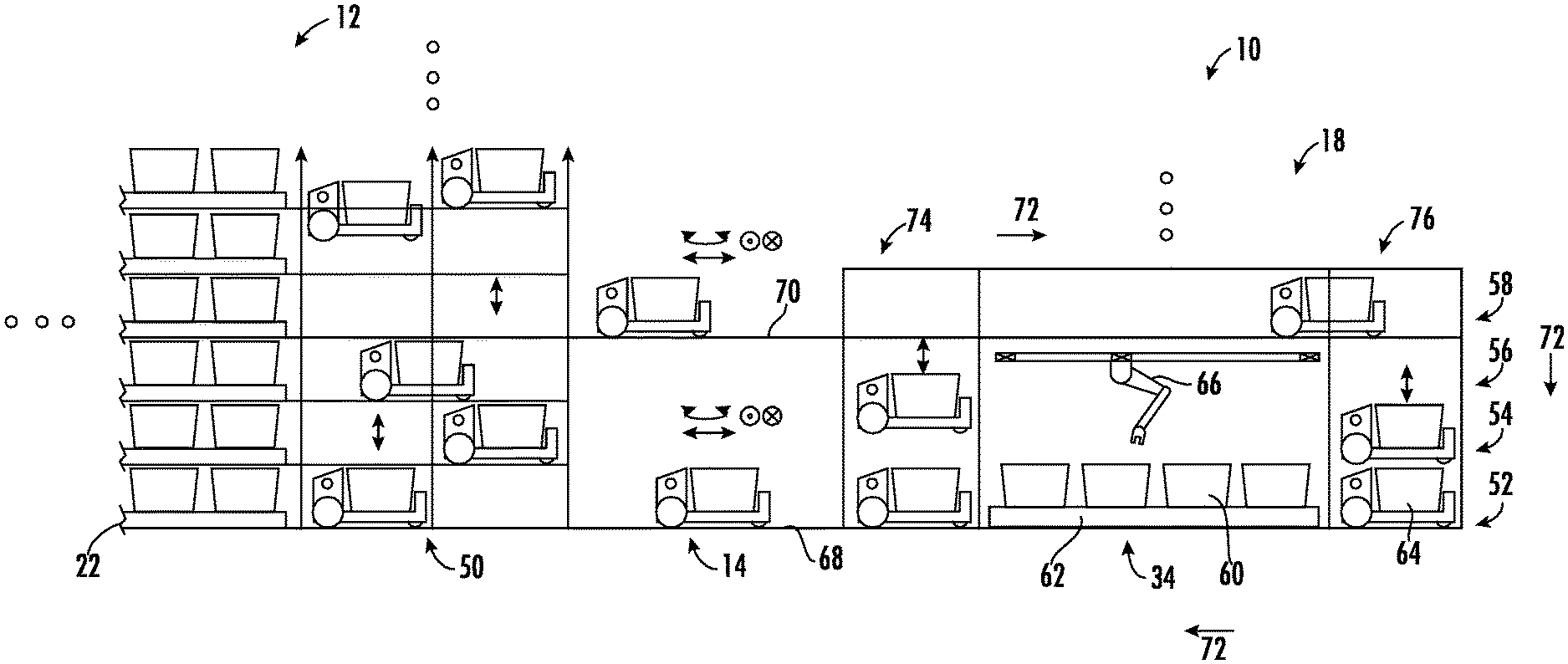
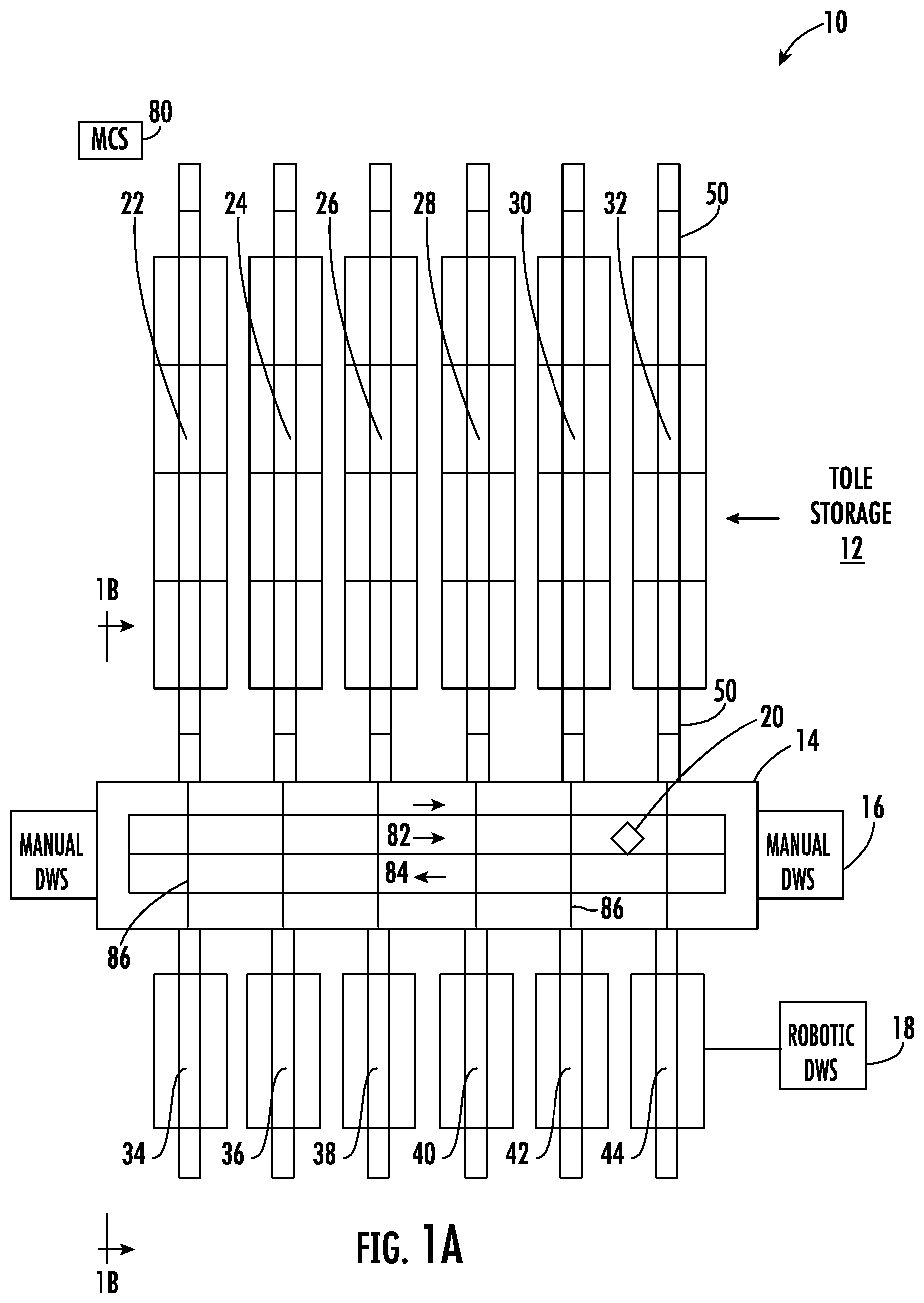


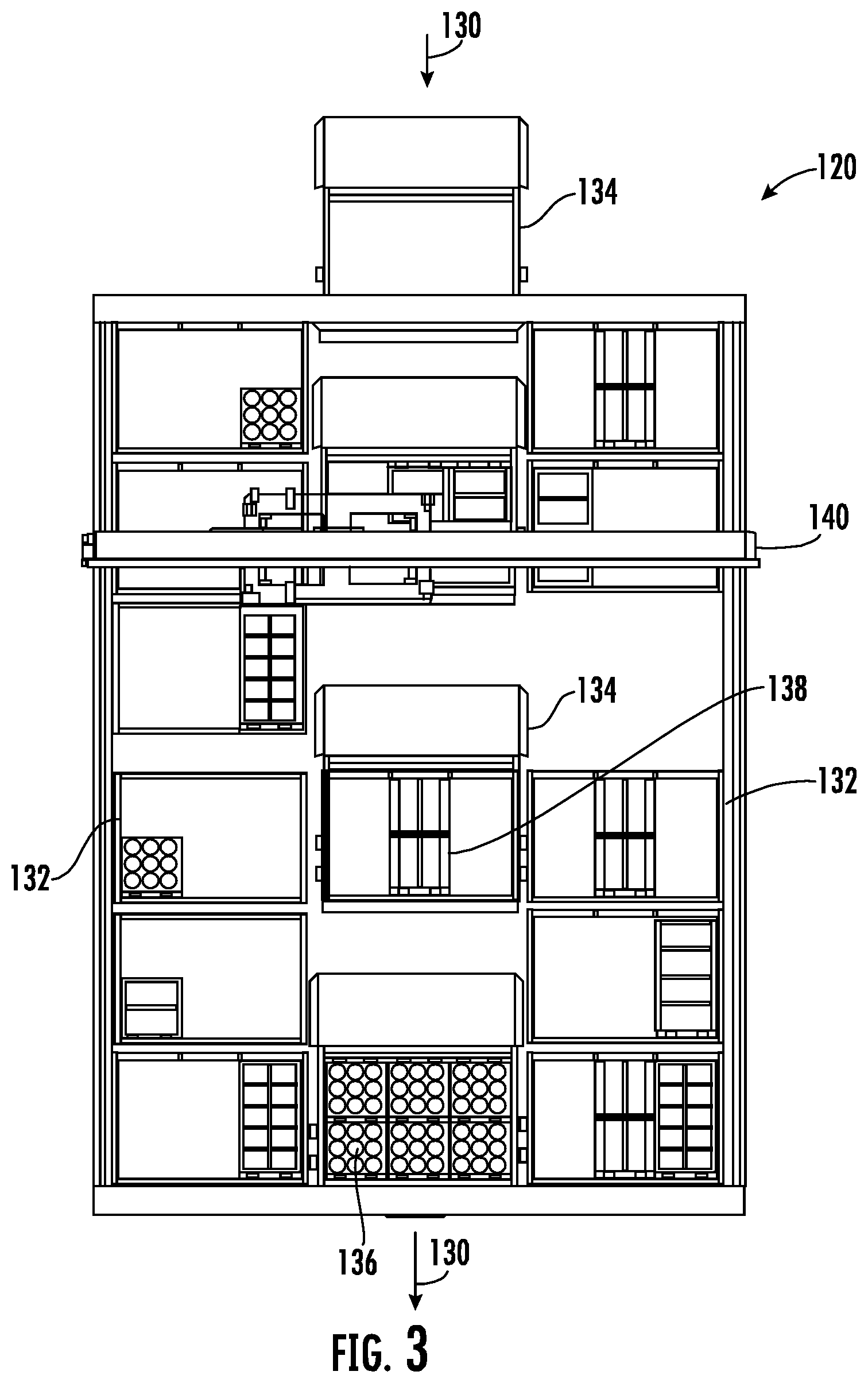
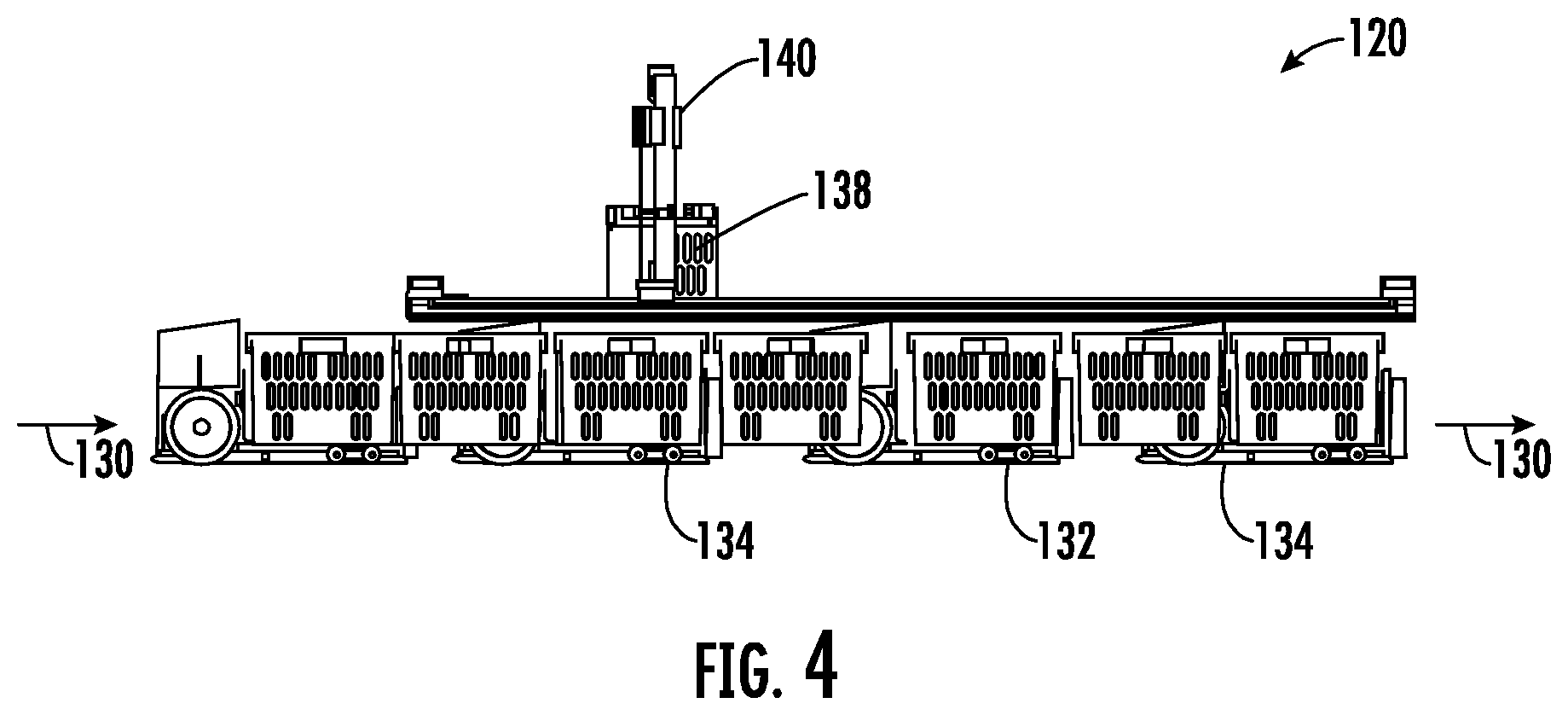
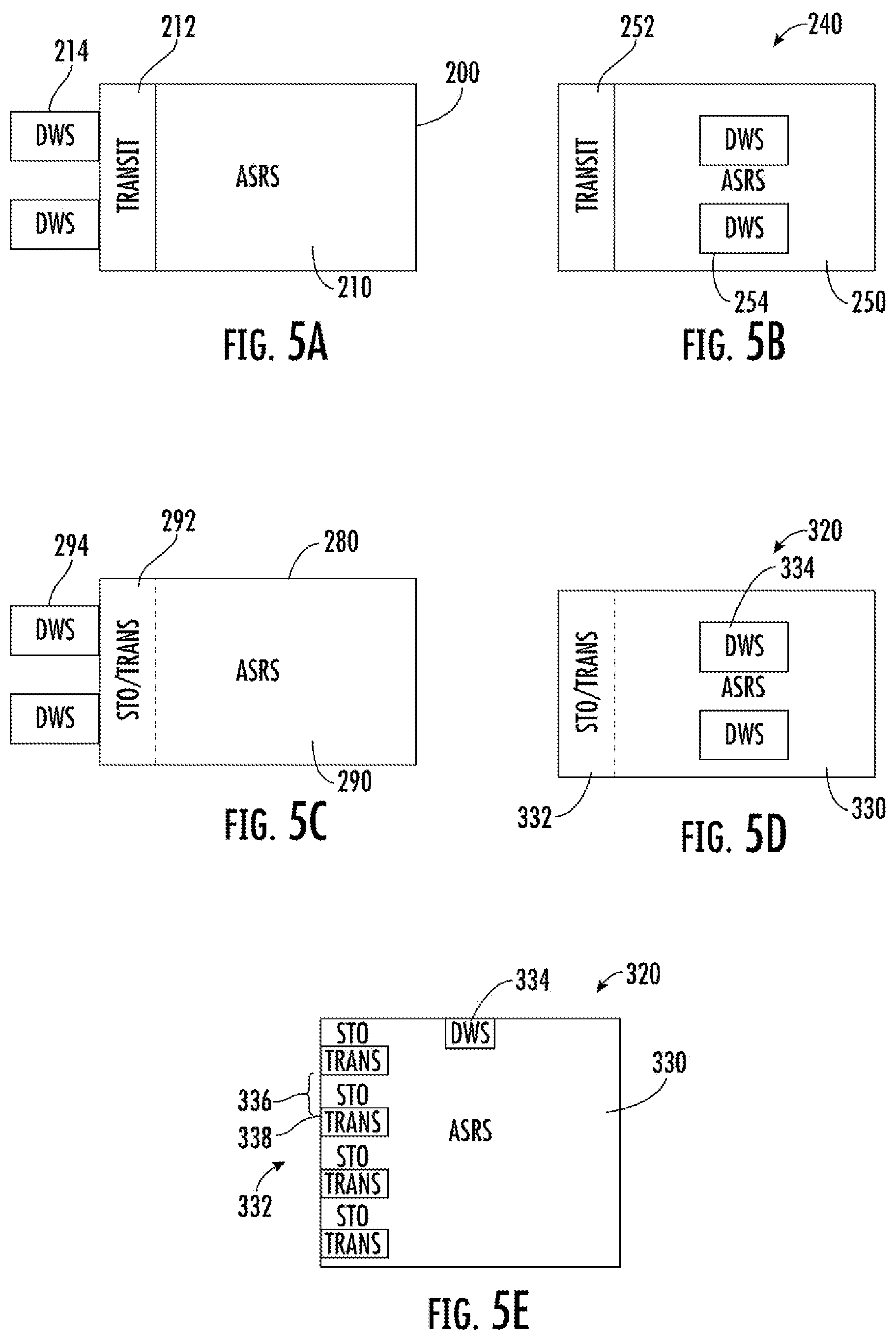



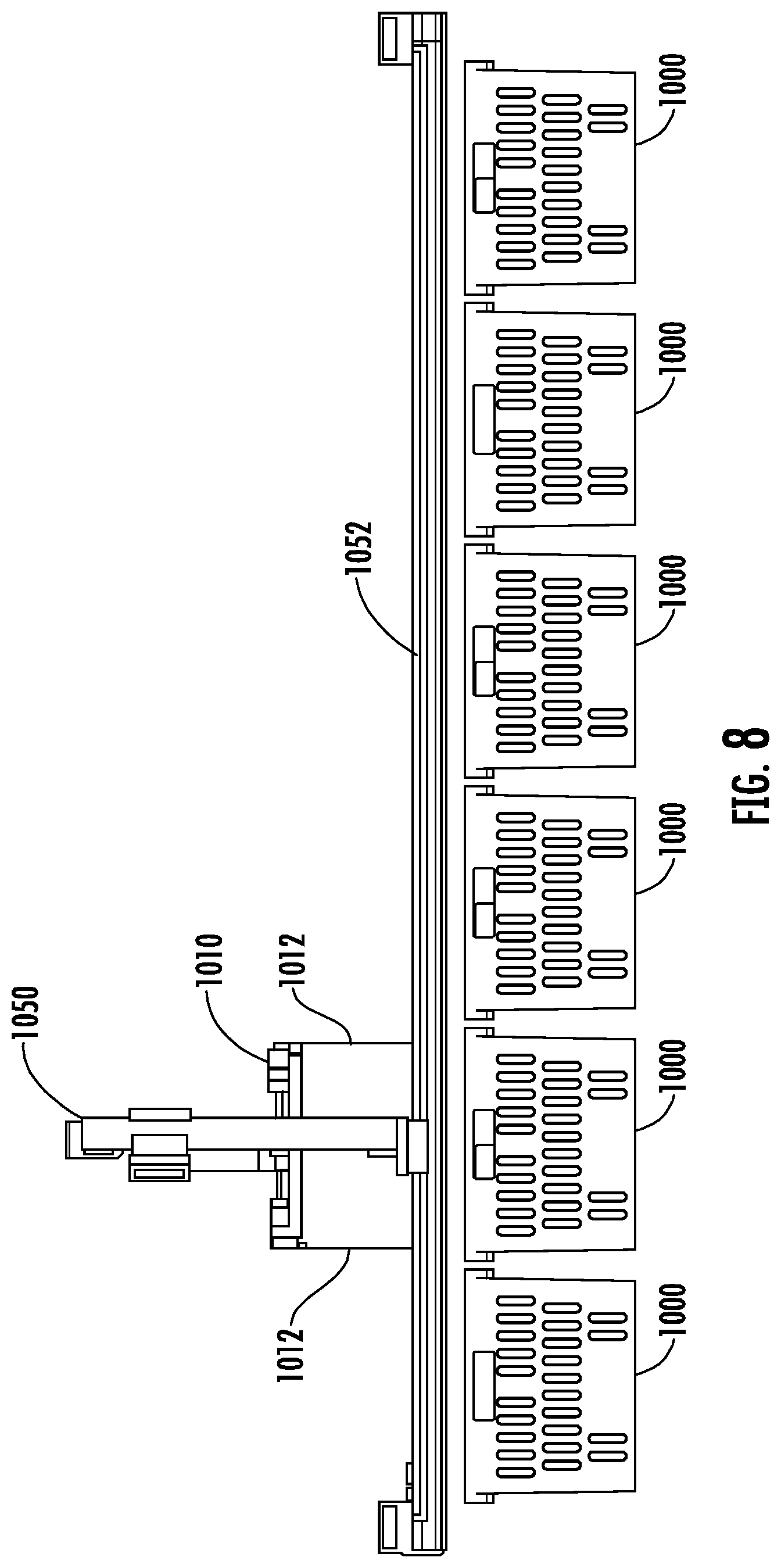

View All Diagrams
| United States Patent Application | 20200156871 |
| Kind Code | A1 |
| Fosnight; William J. ; et al. | May 21, 2020 |
SYSTEM HAVING ROBOTIC WORKSTATION
Abstract
An apparatus is disclosed including a robotic system having a robotic picking workstation, tote storage and retrieval and transit decks. The system has bots that autonomously transport totes from the storage and retrieval system to the robotic picking workstation via the transit decks. The robotic picking workstation may have a picking lane where a robotic handler transports eaches from totes on the bots to order totes in the workstation. The robotic picking workstation further has a queuing buffer where bots are cued for the picking lane.
| Inventors: | Fosnight; William J.; (Windham, NH) ; Lert, JR.; John G.; (Wakefield, MA) | ||||||||||
| Applicant: |
|
||||||||||
|---|---|---|---|---|---|---|---|---|---|---|---|
| Assignee: | ALERT INNOVATION INC. North Billerica MA |
||||||||||
| Family ID: | 69177190 | ||||||||||
| Appl. No.: | 16/676732 | ||||||||||
| Filed: | November 7, 2019 |
Related U.S. Patent Documents
| Application Number | Filing Date | Patent Number | ||
|---|---|---|---|---|
| 62758416 | Nov 9, 2018 | |||
| Current U.S. Class: | 1/1 |
| Current CPC Class: | B65G 1/065 20130101; B65G 1/1378 20130101; B65G 1/0492 20130101; B65G 47/905 20130101; G06Q 10/087 20130101; B65G 47/681 20130101 |
| International Class: | B65G 1/137 20060101 B65G001/137; B65G 47/90 20060101 B65G047/90; B65G 47/68 20060101 B65G047/68; B65G 1/04 20060101 B65G001/04; B65G 1/06 20060101 B65G001/06 |
Claims
1. An automatic storage and retrieval system, comprising: storage shelves for storing containers; mobile robots for transferring containers around within the automatic storage and retrieval system; and a workstation comprising: a first end at which a mobile robot enters the workstation carrying a first container; a second end, opposite the first end, at which the mobile robot exits the workstation, at least one support shelf configured to support at least one second container, the at least one support shelf positioned to at least one side of the mobile robot as the mobile robot moves between the first and second ends of the workstation, and an automated picker for transferring items between the first container and the at least one second container as the mobile robot moves from the first end to the second end of the workstation.
2. The automatic storage and retrieval system of claim 1, wherein the first container is a product container and the at least one second container is a plurality of order containers.
3. The automatic storage and retrieval system of claim 1, wherein the item is a sub-tote fitting within the first container and the at least one second container.
4. The automatic storage and retrieval system of claim 1, further comprising a first deck at a first level and a second deck at a second level different than the first level, the mobile robot capable of travelling between the storage shelves and the workstation on at least one of the first and second levels, and wherein the mobile robot moves through the workstation on the first level.
5. The automatic storage and retrieval system of claim 4, wherein the mobile robot arrives at the first end of the workstation on the second level, and then moves from the second level to the first level for entry into the first end of the workstation.
6. The automatic storage and retrieval system of claim 4, wherein the mobile robot moves from the first level to the second level upon exiting the work station at the second end of the work station.
7. The automatic storage and retrieval system of claim 4, further comprising a queuing buffer where mobile robots are cued for entry into the first end of the workstation.
8. The automatic storage and retrieval system of claim 1, wherein the automated picker is mobile and moves within the workstation.
9. The automatic storage and retrieval system of claim 1, further comprising a picking lane extending between the first and second ends of the workstation along which the mobile robot travels, and wherein the at least one support shelf configured to support at least one second container comprises a plurality of support shelves, on opposed sides of the picking lane, supporting a plurality of second containers.
10. The automatic storage and retrieval system of claim 9, further comprising a control system, the control system controlling the mobile robot to drive along the picking lane to a position next to a selected second container of the plurality of second containers, the automated picker transferring items between the first container and the selected second container upon positioning of the mobile robot next to the selected second container.
11. A system for transferring items between containers within an automatic storage and retrieval system, the system comprising: a mobile robot comprising wheels configured to move the mobile robot, the mobile robot comprising a first support location configured to support a first container; at least one second support location configured to support at least one second container; and an automated picker, mounted on the mobile robot, configured to transfer items between the first container and the at least one second container.
12. The system of claim 11, wherein the first support location is configured to support a product container, and the at least one second support location is configured to support an order container.
13. The system of claim 11, wherein the mobile robot comprises a first mobile robot, the system further comprising a second mobile robot, the at least one second support location comprising a second support location, on the second mobile robot, for supporting a second container of the at least one second containers.
14. The system of claim 13, further comprising a control system controlling one of the first and second mobile robots to collect an item in one of the first second containers, meet up with the other of the first and second mobile robots, and have the automated picker on the first mobile robot transfer the item between the first and second containers.
15. The system of claim 11, wherein the at least one second support location comprises a second support location on the mobile robot.
16. A system for transferring items between containers within an automatic storage and retrieval system, the system comprising: a mobile robot comprising wheels configured to move the mobile robot around within the automatic storage and retrieval system the workstation, the mobile robot comprising: a first container location for supporting a first container, and a second container location for supporting a second container; and an automated picker for transferring items to or from the first and second containers.
17. The system of claim 16, wherein the automated picker is mounted on the mobile robot.
18. The system of claim 17, wherein the first container comprises a product container and the second container comprises an order container, the automated picker configured to transfer one or more items from the product container to the order container.
19. The system of claim 16, further comprising a workstation having a plurality of third container locations configured to support a set of third containers.
20. The system of claim 19, wherein the automated picker is configured to transfer items between the set of third containers and at least one of the first and second containers.
Description
PRIORITY CLAIM
[0001] The present application claims priority to U.S. Provisional Patent Application No. 62/758,416, filed on Nov. 9, 2018, entitled "SYSTEM HAVING ROBOTIC WORKSTATION," which application is incorporated by reference herein in its entirety.
BACKGROUND
Technical Field
[0002] The exemplary and non-limiting embodiments relate generally to systems having picking workstations and automatic storage and retrieval for use in material handling, for example in e-commerce or storage and retrieval.
Brief Description of Prior Developments
[0003] Workstation examples may be found in the following U.S. patents and patent publications (which are hereby incorporated by reference in their entireties): U.S. Pat. No. 9,139,363 which discloses an automated system for transporting payloads; U.S. Patent Publication No. US2016/0355337; and U.S. Patent Publication No. US2017/0313514.
SUMMARY
[0004] The following summary is merely intended to be exemplary. The summary is not intended to limit the scope of the claims.
[0005] In accordance with one aspect, an example is provided in an apparatus comprising a robotic system having a robotic picking workstation, tote storage and retrieval and transit decks. The system has bots that autonomously transport totes from the storage and retrieval system to the robotic picking workstation via the transit decks. The robotic picking workstation has a picking lane where a robotic handler transports eaches from totes on the bots to order totes in the workstation. The robotic picking workstation further has a queuing buffer where bots are cued for the picking lane.
[0006] In accordance with another aspect, the robotic picking workstation has multiple levels where incoming bots flow into the workstation on a first level and outgoing bots flow out of the workstation on a second level.
[0007] In accordance with another aspect, the robotic picking workstation robotic handler comprises a gantry based robotic handler.
[0008] In accordance with another aspect, the present technology relates to an automatic storage and retrieval system, comprising: storage shelves for storing containers; mobile robots for transferring containers around within the automatic storage and retrieval system; and a workstation comprising: a first end at which a mobile robot enters the workstation carrying a product container, a second end, opposite the first end, at which the mobile robot exits the workstation, at least one order container, positioned to at least one side of the mobile robot as the mobile robot moves between the first and second ends of the workstation, and an automated picker robot for transferring items from the product container to at least one order container as the mobile robot moves between the first and second ends of the workstation.
[0009] In accordance with another aspect, the present technology relates to a workstation configured for use with a mobile robot within an automatic storage and retrieval system, the workstation comprising: a first end at which a mobile robot enters the workstation carrying a product container, a second end, opposite the first end, at which the mobile robot exits the workstation, at least one order container within the workstation, and an automated picker robot for transferring items from the product container to at least one order container as the mobile robot moves between the first and second ends of the workstation.
[0010] In accordance with another aspect, the present technology relates to a workstation configured for use with mobile robots within an automatic storage and retrieval system, the workstation comprising: a first end at which a set of first mobile robots enter the workstation, each of the first mobile robots of the set of first mobile robots carrying a product container; at least one order container; and an automated picker configured to pick items from the product containers on the set of first mobile robots, as the first set of mobile robots move through the workstation, and transfer the items to the at least one order container.
[0011] In accordance with another aspect, the present technology relates to a workstation configured for use with mobile robots within an automatic storage and retrieval system, the workstation comprising: a set of shelves configured to store a plurality of order containers; a picking lane adjacent the set of shelves and extending from one end of the workstation to an opposite end of the workstation, mobile robots comprising product containers moving along the picking lane; and an automated picker configured to pick items from the product containers on the mobile robots and transfer the items to the plurality of order containers on the shelves as the mobile robots move through the workstation along the picking lane.
[0012] In accordance with another aspect, the present technology relates to a workstation configured for use with a mobile robot within an automatic storage and retrieval system, the workstation comprising: a first end at which the mobile robot enters the workstation carrying a product container; and a mobile workstation robot configured to move within the workstation, the mobile workstation robot comprising an automated picker for transferring items from the product container of the mobile robot to an order container.
BRIEF DESCRIPTION OF THE DRAWINGS
[0013] FIG. 1A shows a schematic plan a view of a system having a picking-workstation;
[0014] FIG. 1B shows a partial section view of the system of FIG. 1;
[0015] FIG. 2 shows an isometric view of a cartesian robotic workstation;
[0016] FIG. 3 shows a top view of a cartesian robotic workstation;
[0017] FIG. 4 shows a side view of a cartesian robotic workstation;
[0018] FIG. 5A shows a plan view of an exemplary system having a multilevel storage structure;
[0019] FIG. 5B shows a plan view of an exemplary system having a multilevel storage structure;
[0020] FIG. 5C shows a plan view of an exemplary system having a multilevel storage structure;
[0021] FIG. 5D shows a plan view of an exemplary system having a multilevel storage structure;
[0022] FIG. 5E shows a side view of an exemplary system having a multilevel storage structure;
[0023] FIG. 5F shows an isometric view of exemplary system 350 having multilevel storage structure;
[0024] FIG. 6A shows a side view of an exemplary hybrid bot based workstation;
[0025] FIG. 6B shows a side view of an exemplary picker to goods bot based workstation; and
[0026] FIG. 6C shows a side view of an exemplary alternate hybrid bot based workstation.
[0027] FIG. 7 is a top view of the universal gripper mounted on Cartesian robot.
[0028] FIG. 8 is a front view of the universal gripper mounted on Cartesian robot.
[0029] FIGS. 9-19 illustrate transfer of a sub-tote between full totes using a Cartesian robot.
DETAILED DESCRIPTION
[0030] Embodiments of the present technology will now be described with reference to the figures, which in general relate to a robotic dynamic workstation.
[0031] It is understood that the present embodiments may be embodied in many different forms and should not be construed as being limited to the embodiments set forth herein. Rather, these embodiments are provided so that this disclosure will be thorough and complete and will fully convey the invention to those skilled in the art. Indeed, the embodiments are intended to cover alternatives, modifications and equivalents of these embodiments, which are included within the scope and spirit of the invention as defined by the appended claims. Furthermore, in the following detailed description, specific details are set forth in order to provide an understanding of the present embodiments.
[0032] The terms "top" and "bottom," "upper" and "lower" and "vertical" and "horizontal" as may be used herein are by way of example and illustrative purposes only and are not meant to limit the description of the embodiments inasmuch as the referenced item can be exchanged in position and orientation. Also, as used herein, the terms "substantially" and/or "about" mean that the specified dimension or parameter may be varied within an acceptable manufacturing tolerance for a given application. In one non-limiting embodiment, the acceptable manufacturing tolerance is .+-.0.25%.
[0033] FIG. 1A illustrates a schematic plan view of system 10 having a picking-workstation suitable for achieving a high percentage of robot or automatically pickable SKUs. In the exemplary embodiment, workstation traffic and storage/retrieval traffic do not interfere with each other excessively and limit throughput at peak. Referring also to FIG. 1B, there is shown a partial section view of system 10. The topology of system 10 is intended to be exemplary and more or less sub modules or systems of system 10 may be arranged in any number of ways. By way of non-limiting example, the topology as disclosed in US Patent Publication No. US2017/0313514 which is incorporated by reference herein in its entirety, may be employed but with a much higher workstation density and a leaned-down transit deck. FIG. 1A shows system 10 plan view with tote storage 12, transit decks 14, manual dynamic workstations 16, robotic dynamic workstations 18 and bots 20. Tote storage array 12 has six storage aisles 22, 24, 26, 28, 30, 32, and verticals 50 at opposing ends of the aisles. Each aisle allows bots 20 to transit from end to end where bots 20 may pick or place totes on opposing sides of the aisle for storage or retrieval. Verticals 50 are provided to allow bots 20 to selectively climb up or down to transit from level to level of storage array 12 or transit decks 14. Robotic dynamic workstation 18 has six workstation aisles 34, 36, 38, 40, 42, 44, each with a single elongated bay to allow more than 6 totes per shelf although less may be provided (for example, 4 as seen in FIG. 1B). Each workstation effectively uses four storage levels 52, 54, 56, 58 as its working envelope. The bottom level 52 may be the picking lane, where the order totes 60 are held on shelves 62 while product bots 64 flow through and donate eaches or subtotes picked by the cartesian robot 66. This is also the exit lane 52, because as soon as the pick is complete, the product bot 64 will exit the workstation 34 onto the lower transit deck 68 and travel to its next storage location. The second level 54 is the clearance space occupied by the picked payload (each or subtote) as it moves from source to destination tote, and the third level 56 is occupied by the cartesian robot mechanism. The fourth level is the entry lane and queuing buffer. The exemplary topology preserves a 2-elevation 68, 70 architecture and unidirectional 72 bot flows. In alternate aspects the bot flow may be opposite or bi-directional. Here, though, the bots may flow through workstation 34 from top to bottom, entering at workstation level 4 (70, 58) from the vertical tower 74 adjacent to the transit deck 70 and queuing up behind bots already in queue. At the end of that lane, the bot would enter the vertical tower 76 and drop down to workstation level 1 (68, 52). When commanded by MCS 80 (Master Control System), the bot enters the picking lane and drives forward to position itself next to the target destination tote. The cartesian robot 66 then (or in parallel) moves to the bot, extracts the target each or subtote and places it into the target tote/subtote. As with a manual station 16, as soon as the robot 66 end-arm-effector clears the product tote 60, the Alphabot 64 robot moves on and exits the picking lane onto the transit deck 68 so that the next product bot can move to its position, overlapping the put-away move by the picking robot. One more empty level per workstation tier may be provided, for a total of 5 levels per tier, in order to provide adequate maintenance clearance on the top transit deck 70 there would be 2-levels (roughly 30'') separating the top transit deck of a lower workstation tier and the bottom transit deck of an upper workstation (not shown--above workstation 34). By way of example, three workstation tiers may be provided in 15 storage levels, requiring roughly 20' clear height. By way of further example, a 15-level, 6-aisle system configured as shown in FIGS. 1A & 1B may support a total of 18 workstations along a deck that's only about 100' in length. Here with an average sustained pick rate of 400 eaches per hour per workstation, these 18 workstations would pick a total of 7,200 eaches per hour. As bots would be queuing for the workstation within the workstation aisles and not on the deck, a high rate of bot flow on the deck may be provided, with two one-way avenues 82, 84 serving as main east-west arteries, and the streets 86 allowing crossing over the deck to enter an aisle. Here, the only stopping on the deck may be by bots on streets yielding right of way to bots on the avenues. Further, as bots normally do not park in queue on the deck, the streets and aisles may be aligned. In alternate aspects, dedicated decks may be provided, for example, a deck may be placed between decks 68, 70 that is dedicated to either streets or avenues where similarly decks 68, 70 may be dedicated such that streets are dedicated on one level and avenue(s) on a different level. Here, levels may be provided to minimize traffic congestion of the bots. Manual workstations 16 may be provided the ends of the transit decks 14. Sequencing the flow of bots through the pick may be largely unconstrained by having multiple order totes active concurrently. With three levels between the entry 52 and exit 58 levels of each workstation tier, a single express deck may be provided within each workstation tier, positioned midway between workstation levels 2 (54) and 3 (56), and running across the front of the storage aisles, sufficient to keep dispense and replenishment traffic separate from picking traffic.
[0034] Referring now to FIG. 2, there is shown an isometric view of a cartesian robotic workstation 120 suitable for use in a robotic dynamic workstation, for example as shown in FIG. 1. Alternately cartesian robotic workstation 120 may be directly integrated within a tote storage structure, for example, on the top level or within levels of the tote storage structure shown in FIG. 1. Referring also to FIGS. 3 and 4, there is shown top and side views respectively of workstation 120. Workstation 120 has a picking lane 130, where the order totes 132 are held on shelves while product bots 134 flow through and donate eaches 136 or subtotes 138 picked by the cartesian robot 140. Cartesian robot 140 is shown with exemplary tooling to pick totes and may have features as disclosed in U.S. patent application Ser. No. 16/058,065 filed Aug. 8, 2018, which application is incorporated by reference herein in its entirety. Portions of this application are set forth below. Alternately, robot 140 may have suitable tooling to pick and place eaches or to pick and place both eaches and subtotes. Alternately cartesian robot 140 may be one or more multi degree of freedom articulated arm(s) with suitable tooling where the articulated arm(s) may be mounted stationary with respect to the product totes or may be mounted on one or more gantries, shuttles stages or otherwise with respect to the product totes. Lane 130 serves as an entry and exit lane, where as soon as pick from a product tote for placement in an order tote is complete, the product bot 134 may exit the workstation 120, for example, onto a transit deck or storage lane and travel to its next storage location. Clearance space is provided above the product and order totes occupied by the picked payload (each or subtote) as it moves from source tote to destination tote. The area above the clearance space is occupied by the cartesian robot mechanism. In this embodiment, the bots would flow through the workstation from entry to exit where at either end the bots can further place spent product totes and pick product totes to fulfill the next each within the storage structure and can enter lanes, towers and drop up or down or transit decks such that the bots can autonomously access any portion of the tote storage structure. When commanded by MCS, the bot 134 enters the picking lane 130 and drives forward to position itself next to the target destination tote. The cartesian robot 140 then moves to the bot, extracts the target each or subtote and places it into the target tote/subtote. Just as with the manual station, as soon as the robot end-arm-effector clears the product tote, the product bot robot moves on and exits the picking lane onto the transit deck so that the next product bot can move to its position, overlapping the put-away move by the picking robot. In alternate aspects the bot enters the picking lane and drives forward where the cartesian robot tracks movement of the bot while both are still in motion, dynamically extracts the target each or subtote and places it into the target tote/subtote. Although a single gantry and pick/place robot are shown, more may be provided within the workstation.
[0035] Referring now to FIG. 5A, there is shown a plan view of exemplary system 200 having multilevel storage structure 210, multilevel transit decks 212 positioned adjacent to multilevel storage structure 210 and workstations 214 positioned adjacent to multilevel transit decks 212. The features of exemplary system shown in FIG. 5A may be as disclosed with respect to FIGS. 1A and 1B. Referring also to FIG. 5B, there is shown a plan view of exemplary system 240 having multilevel storage structure 250, multilevel transit decks 252 positioned adjacent to multilevel storage structure 250 and workstations 254 positioned on top of or within multilevel storage structure 210. By way of example, the features of the exemplary system shown in FIG. 5B may incorporate the workstation features disclosed with respect to FIGS. 1A, and 2-4. Here, the workstation may be embedded within the tote storage structure. Referring also to FIG. 5C, there is shown a plan view of exemplary system 280 having multilevel storage structure 290, multilevel transit decks and storage structure 292 positioned adjacent to & within multilevel storage structure 290 and workstations 294 positioned adjacent to multilevel transit decks and storage structure 292. The multilevel transit decks and storage structure 292 may have for example three storage levels above each transit deck level, for example as seen in FIG. 5E. By way of example, the features of the exemplary system shown in FIG. 5C may incorporate the workstation features disclosed with respect to FIGS. 1A, and 2-4. Here, the workstation may be adjacent to or embedded within the tote storage structure. Referring also to FIGS. 5D and 5E, there are shown plan and side views respectively of exemplary system 320 having multilevel storage structure 330, multilevel transit decks and storage structure 332 positioned adjacent to & within multilevel storage structure 330 and workstations 334 positioned within storage structure 330. The multilevel transit decks and storage structure 332 may have for example three storage levels 336 above each transit deck level 338. By way of example, the features of the exemplary system shown in FIGS. 5D and 5E may incorporate the workstation features disclosed with respect to FIGS. 1A, and 2-4. Here, the workstation may be embedded within the tote storage structure.
[0036] Referring now to FIG. 5F, there is shown an isometric view of exemplary system 350 having multilevel storage structure 360, multilevel transit decks 362 and storage structure 364 positioned adjacent to & within multilevel storage structure 360 where multilevel transit decks 362 and storage structure 364 are stacked with respect to each other to increase storage density. Overhead space 366 and depth 368 are provided such that sufficient overhead space 366 provides headroom for bots to pass and be serviced and depth 368 provides space for bots to move from aisle to aisle without creating bot interference or excessive traffic congestion. The features of exemplary system 350 shown in FIG. 5F may be as disclosed with respect to FIGS. 1A and 1B. In the exemplary embodiment system 350, the upper level 370 is shown as also being a transit deck where verticals 372 are provided to allow bots to selectively access different levels of storage structure 360 and traverse transit deck 370. Workstations 374 are also provided on transit deck 370 and may have features as disclosed with respect to the workstation as disclosed in FIGS. 2-4 or otherwise. Static workstations 376 may also be provided for tote induction and removal for use in applications such as decant, order tote removal or otherwise.
[0037] Referring now to FIG. 6A, there is shown a schematic side view of bot based workstation 400 or hybrid workstation 400 having bots 406 and 410. In the embodiment shown, the bots may be autonomous where one bot may have an order tote 412 and the other a product tote 414. One of the bots, in the example shown bot 410 has an articulated arm or robot 416 provided to pick eaches from the product tote 414 and place the each into order tote 412. Here, bot 410 may for example travel through the storage and retrieval system autonomously optimally to engage bots with product totes until the desired mix of eaches in the order tote 412 is satisfied at which point bot 410 dispatches tote 412 for delivery to fulfill the order and picks up a new order tote to complete a subsequent order. Referring now to FIG. 6B, there is shown a schematic side view of bot based workstation 440 or picker to goods workstation 440 having single bot 446. In the embodiment shown, the bot may be autonomous and having two tote locations--an order tote 452 and a product tote 454. Bot 446 has an articulated arm or robot 456 provided to pick eaches from the product tote 454 and place the each into order tote 452. Here, bot 446 may for example travel through the storage and retrieval system autonomously optimally to engage tote storage locations, for example, removing product totes and picking the appropriate each until the desired mix of eaches in the order tote 452 is satisfied at which point bot 446 dispatches tote 452 for delivery to fulfill the order and picks up a new order tote to complete a subsequent order. Referring now to FIG. 6C, there is shown a schematic side view of bot based workstation 480 or alternate hybrid workstation 480 having single bot 486. In the embodiment shown, the bot may be autonomous and having two tote locations--an order tote 492 and a product tote 494. Bot 446 is adapted to be dispatched to an articulated arm or robot 496 provided to pick eaches from the product tote 494 and place the each into order tote 452. By way of example, robot 496 may have features as disclosed with respect to FIGS. 2-4. Here, bot 486 may for example travel through the storage and retrieval system autonomously optimally to engage tote storage locations, for example, removing product totes and travelling to robot 496 for picking the appropriate each until the desired mix of eaches in the order tote 492 is satisfied at which point bot 486 dispatches tote 492 for delivery to fulfill the order and picks up a new order tote to complete a subsequent order.
[0038] As noted above, workstation 120 has a picking lane 130, where the order totes 132 are held on shelves while product bots 134 flow through and donate eaches 136 or subtotes 138 picked by the cartesian robot 140. Cartesian robot 140 may have features as disclosed in U.S. patent application Ser. No. 16/058,065 filed Aug. 8, 2018, which application has been incorporated by reference herein in its entirety. FIGS. 7 to 19 illustrate a universal gripper 1010 mounted to a Cartesian robot 1050, which may be an example of Cartesian robot 140 mentioned above. The robot 1050 is driven along a pair of rails 1052 by a pair of motors 1054 (FIG. 9) on the robot 1050. For example, each rail 1052 may include toothed timing belt drives, driven by one through-shaft servo motor 1054. The through shaft is attached to the two parallel drives to ensure the two sides are driven uniformly.
[0039] The robot 1050 further includes a shaft 1058 which affixes within hub 1018 of the gripper 1010 to translate and/or rotate the gripper 1010. FIG. 7 is a top view of the robot 1050 and gripper 1010 over a number of totes 1000. FIG. 8 is a side view of the robot 1050 and gripper 1010 over a number of totes 1000. And FIGS. 9-19 are perspective views of the robot 1050 and gripper 1010 transferring a sub-tote 1002 from one tote to another tote. The Cartesian robot and gripper may be mounted within the storage racking to enable in-storage transfers of sub-totes between the full totes. This is used to defragment the storage; i.e. combine empty sub-totes together in full totes, and thereby increase storage density within the system.
[0040] FIG. 9 shows the gripper 1010 in a fully raised position. Depending on tine length, gripper does not need to be raised to full height position when not carrying a sub-tote. FIG. 10 shows the gripper 1010 lowering its tines into slots in top exterior flange of a one-sixth sub-tote 1002a. FIG. 11 shows the first pair of gripper tines 1012 fully inserted into sub-tote slots, with the tines in sub-tote driven apart to position lifting tabs underneath the slots.
[0041] The figures also show a second one-sixth sub-tote 1002a in the position next to (or opposite) the sub-tote 1002a to be transferred. The second pair of gripper tines on the opposite side penetrate through the slots in the top exterior flanges of this opposite side sub-tot. However, the second pair of tines are not driven apart thereby allowing the second pair of tines to be lifted without lifting the opposite side sub-tote. If the one-sixth, or one-half sub-totes on opposite sides of the full tote are desired to be lifted together, then all tines are driven apart to position the lifting tabs underneath the top exterior flanges of both sub-totes.
[0042] FIG. 12 shows the sub-tote 1002a in the half-lifted position out of the source tote 1000, supported on the first pair of tines 1012. FIG. 13 shows the sub-tote 1002a fully lifted out of the source tote 1000. FIG. 14 shows the Cartesian robot 1050 translating and rotating the gripper 1010 and sub-tote 1002a simultaneously. Rotation of the sub-tote 1002a is needed in this example, as the sub-tote 1002a is being placed in the opposite side of the destination tote, as compared to the source tote. FIG. 15 shows continued rotation and translation of the sub-tote 1002a on the gripper 1010 and robot 1050. If the sub-tote 1002a was to be positioned in the middle of the other side, or opposite corner of the source corner location, the tines would also be translated within the gripper 1010 during the movement of the gripper.
[0043] FIG. 16 shows the Cartesian robot 1050 having translated and rotated the sub-tote 1002a over its destination position. FIG. 17 shows the Cartesian robot having partially lowered the gripper 1010 and sub-tote 1002a into the destination location. FIG. 18 shows the Cartesian robot having fully lowered the gripper and sub-tote into the destination location. Once in this position, the tines 1012 are moved toward each other to disengage the lifting tabs from underneath the top external flange of the sub-tote. The tines on the opposite side of the gripper are positioned to allow them to extend into the slots of other sub-totes already contained within the destination full tote. As an alternative, the gripper 1010 could be lengthened to permit the tines not lifting or lowering sub-totes to straddle the outside of the full tote. FIG. 19 shows the gripper 1010 and robot 1050 after releasing the sub-tote 1002a in its destination position. The gripper 1010 with its tines 1012 are lifted out of the slot of the sub-tote 1002a.
[0044] In accordance with an example embodiment, an apparatus may be provided comprising a robotic system having a robotic picking workstation, tote storage and retrieval and transit decks. The system has bots that autonomously transport totes from the storage and retrieval system to the robotic picking workstation via the transit decks. The robotic picking workstation has a picking lane where a robotic handler transports eaches from totes on the bots to order totes in the workstation. The robotic picking workstation further has a queuing buffer where bots are cued for the picking lane.
[0045] In accordance with another aspect, the robotic picking workstation has multiple levels where incoming bots flow into the workstation on a first level and outgoing bots flow out of the workstation on a second level.
[0046] In accordance with another aspect, the robotic picking workstation robotic handler comprises a gantry based robotic handler.
[0047] In accordance with an example embodiment, an apparatus may be provided comprising at least one processor and at least one non-transitory memory including computer program code, the at least one memory and the computer program code configured to, with the at least one processor, cause the apparatus to queue and schedule material through the robotic workstation.
[0048] Any combination of one or more computer readable medium(s) may be utilized as the memory. The computer readable medium may be a computer readable signal medium or a non-transitory computer readable storage medium. A non-transitory computer readable storage medium does not include propagating signals and may be, for example, but not limited to, an electronic, magnetic, optical, electromagnetic, infrared, or semiconductor system, apparatus, or device, or any suitable combination of the foregoing. More specific examples (a non-exhaustive list) of the computer readable storage medium would include the following: an electrical connection having one or more wires, a portable computer diskette, a hard disk, a random access memory (RAM), a read-only memory (ROM), an erasable programmable read-only memory (EPROM or Flash memory), an optical fiber, a portable compact disc read-only memory (CD-ROM), an optical storage device, a magnetic storage device, or any suitable combination of the foregoing.
[0049] In summary, in one example, the present technology relates to an automatic storage and retrieval system, comprising: storage shelves for storing containers; mobile robots for transferring containers around within the automatic storage and retrieval system; and a workstation comprising: a first end at which a mobile robot enters the workstation carrying a first container; a second end, opposite the first end, at which the mobile robot exits the workstation, at least one support shelf configured to support at least one second container, the at least one support shelf positioned to at least one side of the mobile robot as the mobile robot moves between the first and second ends of the workstation, and an automated picker for transferring items between the first container and the at least one second container as the mobile robot moves from the first end to the second end of the workstation.
[0050] In another example, the present technology relates to a system for transferring items between containers within an automatic storage and retrieval system, the system comprising: a mobile robot comprising wheels configured to move the mobile robot, the mobile robot comprising a first support location configured to support a first container; at least one second support location configured to support at least one second container; and an automated picker, mounted on the mobile robot, configured to transfer items between the first container and the at least one second container.
[0051] In a further example, the present technology relates to a system for transferring items between containers within an automatic storage and retrieval system, the system comprising: a mobile robot comprising wheels configured to move the mobile robot around within the automatic storage and retrieval system the workstation, the mobile robot comprising: a first container location for supporting a first container, and a second container location for supporting a second container; and an automated picker for transferring items to or from the first and second containers.
[0052] The foregoing detailed description has been presented for purposes of illustration and description. It is not intended to be exhaustive or to limit the description to the precise form disclosed. Many modifications and variations are possible in light of the above teaching. The described embodiments were chosen in order to best explain the principles of the claimed system and its practical application to thereby enable others skilled in the art to best utilize the claimed system in various embodiments and with various modifications as are suited to the particular use contemplated. It is intended that the scope of the method be defined by the claims appended hereto.
* * * * *
D00000

D00001

D00002

D00003

D00004

D00005

D00006

D00007

D00008

D00009

D00010

D00011

D00012
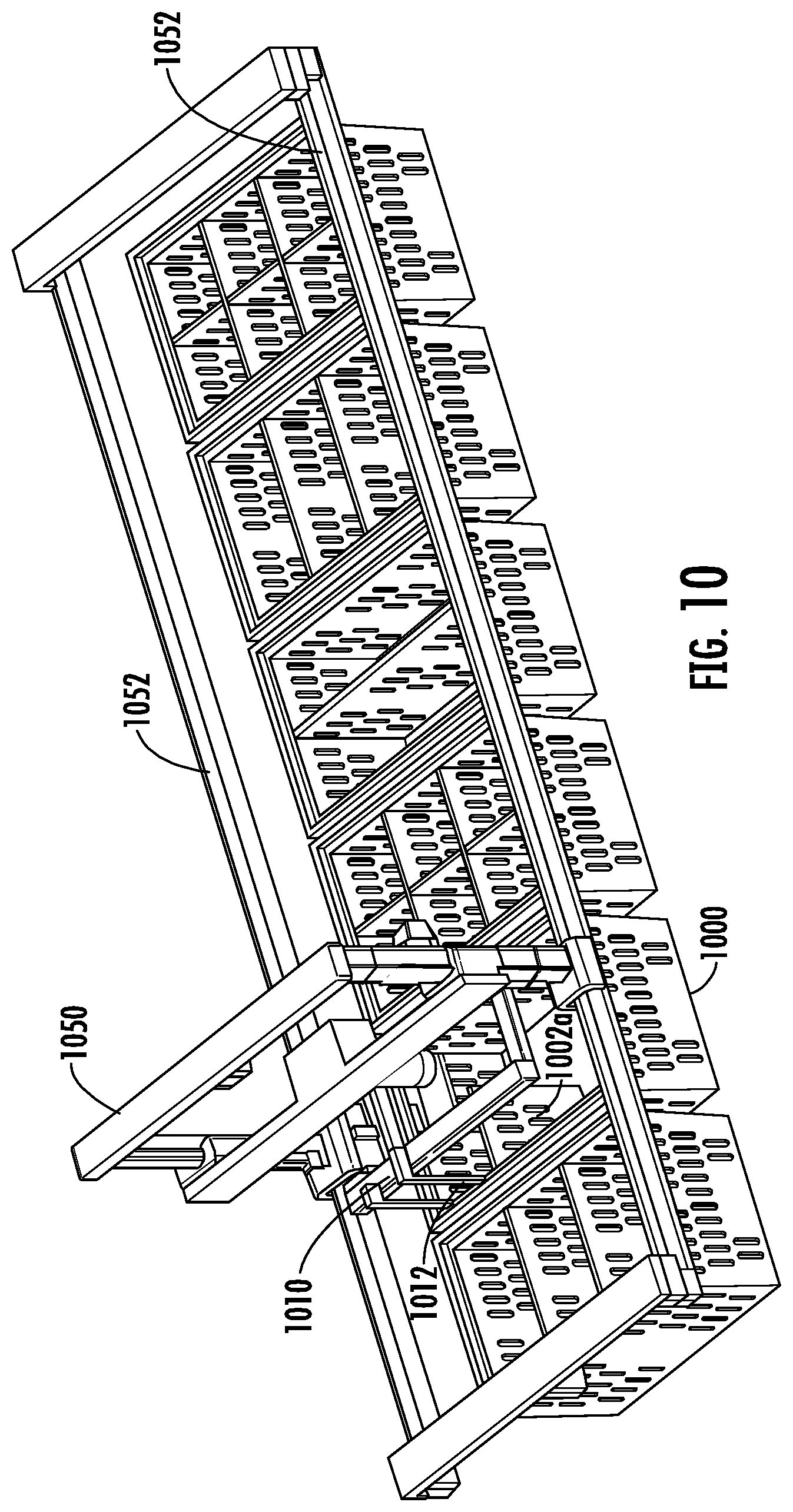
D00013

D00014

D00015
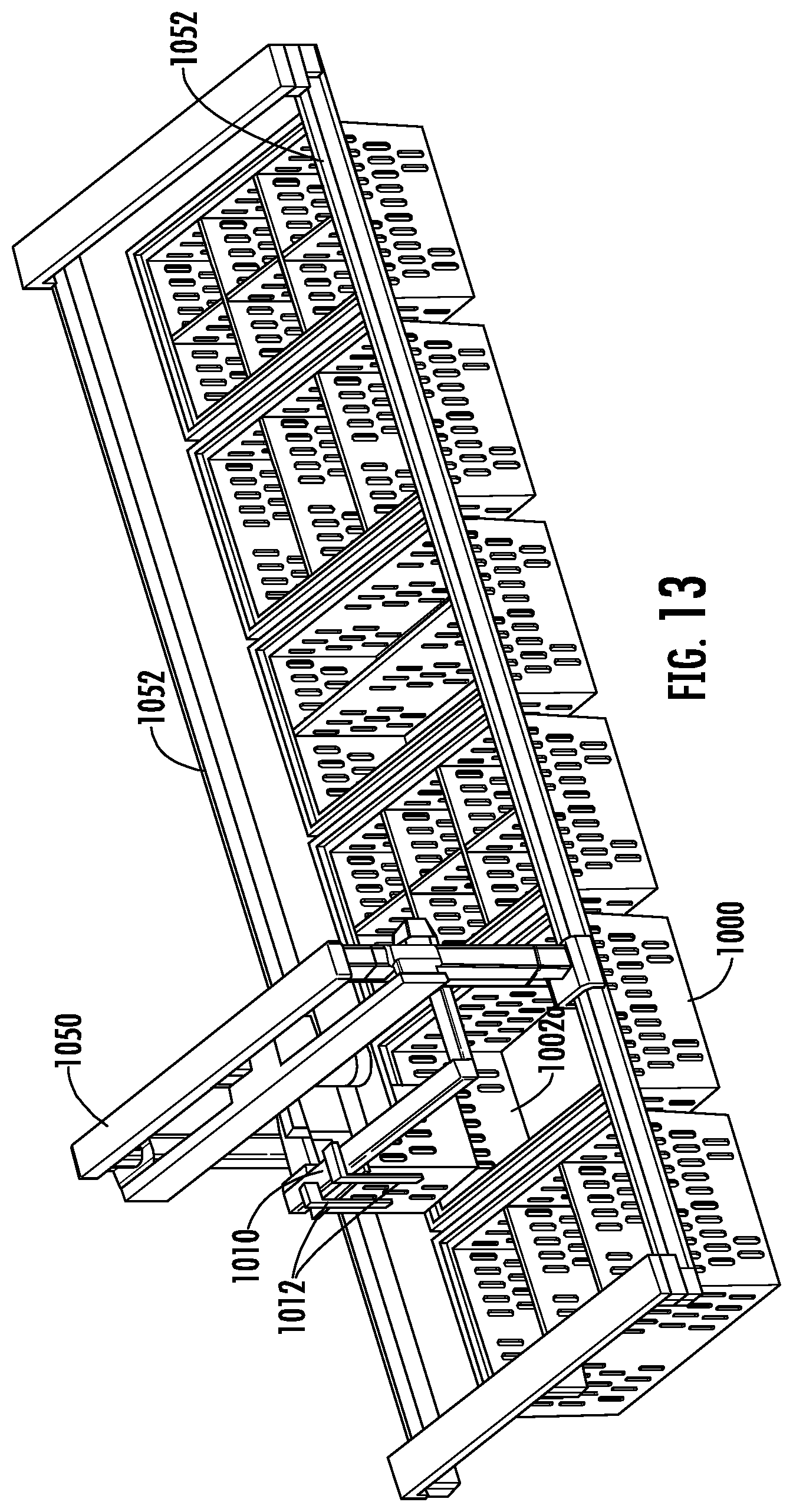
D00016

D00017

D00018
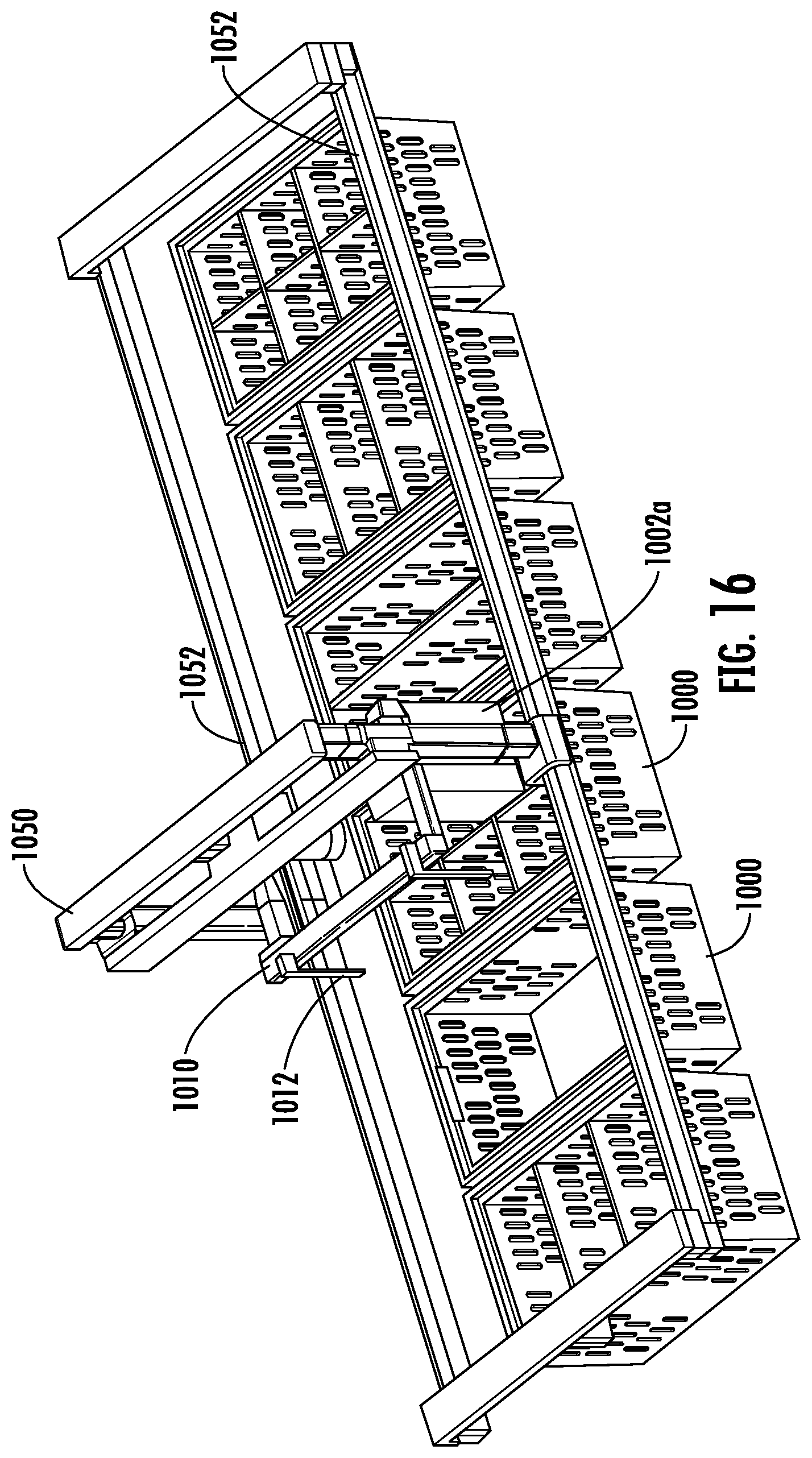
D00019

D00020

D00021

XML
uspto.report is an independent third-party trademark research tool that is not affiliated, endorsed, or sponsored by the United States Patent and Trademark Office (USPTO) or any other governmental organization. The information provided by uspto.report is based on publicly available data at the time of writing and is intended for informational purposes only.
While we strive to provide accurate and up-to-date information, we do not guarantee the accuracy, completeness, reliability, or suitability of the information displayed on this site. The use of this site is at your own risk. Any reliance you place on such information is therefore strictly at your own risk.
All official trademark data, including owner information, should be verified by visiting the official USPTO website at www.uspto.gov. This site is not intended to replace professional legal advice and should not be used as a substitute for consulting with a legal professional who is knowledgeable about trademark law.